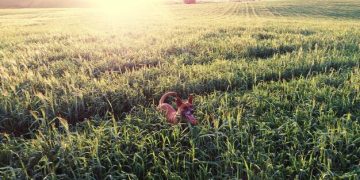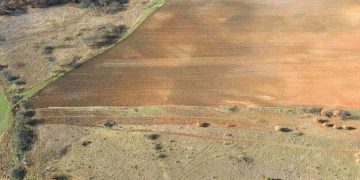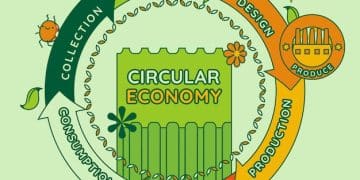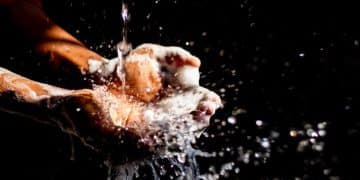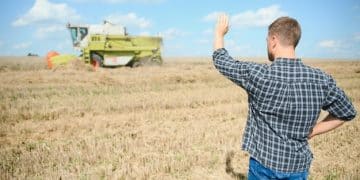What Are the Projected Water Savings for US Farms Using Drip Irrigation?
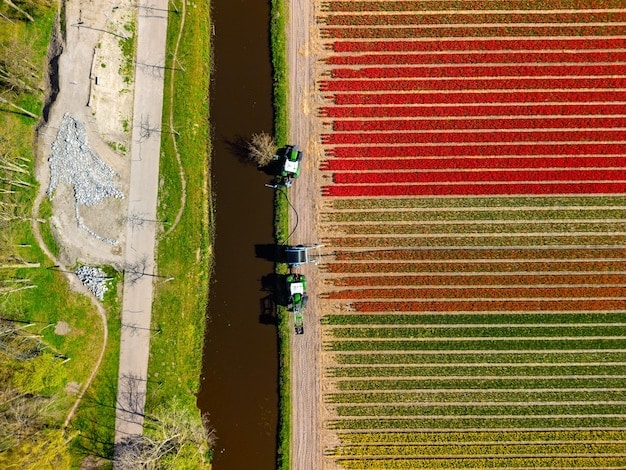
What are the Projected Water Savings for US Farms Adopting Drip Irrigation in the Next 3 Years? Implementing drip irrigation is expected to substantially reduce water consumption in US agriculture, offering savings through precise water delivery directly to plant roots, minimizing waste from evaporation and runoff.
American agriculture faces increasing pressure to conserve water. With droughts becoming more frequent and water resources dwindling, farmers are seeking efficient irrigation methods. One promising solution lies in drip irrigation.
So, what are the Projected Water Savings for US Farms Adopting Drip Irrigation in the Next 3 Years? Let’s delve into the potential impact of this technology on water conservation in the United States, exploring its benefits and projecting its future role.
Understanding Drip Irrigation and Its Advantages
Drip irrigation, also known as micro-irrigation, is a method that delivers water directly to the root zone of plants. This is achieved through a network of pipes, tubing, and emitters, resulting in a slow and precise application of water. Unlike traditional methods like sprinklers or flood irrigation, drip irrigation minimizes water waste significantly.
How Drip Irrigation Works
The system typically involves a water source, filtration unit, pressure regulator, main lines, lateral lines, and emitters. The filtration unit removes debris that could clog the emitters. The pressure regulator ensures consistent water flow. The water then flows through the lines and is released slowly through the emitters, delivering water directly to the plant roots.
Key Advantages of Drip Irrigation
- Reduced Water Consumption: Drip irrigation can reduce water use by 30-70% compared to traditional methods.
- Improved Crop Yields: Plants receive a consistent water supply, leading to healthier growth and higher yields.
- Decreased Fertilizer Use: Water and fertilizer can be delivered together, improving nutrient uptake and reducing waste.
- Weed Control: By delivering water directly to the plants, weed growth is minimized between rows.

In summary, drip irrigation offers numerous benefits, making it an attractive option for farmers looking to improve water efficiency and crop productivity. Its ability to target water delivery reduces waste, leading to significant water savings.
Current Adoption Rates of Drip Irrigation in the US
While the advantages of drip irrigation are clear, the adoption rate in the United States varies by region and crop type. Understanding the current landscape is essential for projecting future water savings.
Regional Variations in Adoption
States like California, Florida, and Arizona, which face significant water scarcity, have higher adoption rates of drip irrigation. In contrast, regions with more abundant water resources, such as the Midwest, have been slower to adopt this technology.
Factors influencing these variations include the cost of implementation, availability of technical expertise, and regulatory pressures. In states with stringent water regulations, farmers are more likely to invest in efficient irrigation methods like drip irrigation.
Crop-Specific Adoption Trends
Certain crops are more commonly irrigated with drip systems. High-value crops like fruits, vegetables, and nuts often benefit most from the precise water and nutrient delivery that drip irrigation provides. Field crops like corn and soybeans, which have traditionally been irrigated using other methods, are gradually seeing increased adoption of drip irrigation.
- Fruits and Vegetables: High adoption rates due to improved quality and yield.
- Nuts: Essential for almond and walnut growers in water-stressed regions.
- Field Crops: Gradual increase as farmers seek water conservation strategies.
Overall, the adoption of drip irrigation in the US is on an upward trend, driven by the need for water conservation and the proven benefits of this technology. As more farmers become aware of the potential savings, the adoption rate is expected to continue to rise, further highlighting what are the Projected Water Savings for US Farms Adopting Drip Irrigation in the Next 3 Years?
What are the Projected Water Savings for US Farms Adopting Drip Irrigation in the Next 3 Years?
Predicting the precise water savings is complex, but considering the current adoption rates and trends, realistic projections can be developed. Several factors influence these projections.
Expanding drip irrigation use will be key to answering ‘what are the Projected Water Savings for US Farms Adopting Drip Irrigation in the Next 3 Years?‘ in a meaningful way.
Factors Influencing Water Savings Projections
Several factors could influence the total amount of water potentially saved. These include:
- Governmental policies and incentives that help farmers offset start up costs
- Overall awareness of sustainable farming practices among US farmers
- Growing concerns related to drought and water conservation
Potential Scenarios for Water Savings
Based on current trends, a conservative estimate suggests that if drip irrigation adoption increases by 10% over the next three years, US farms could save approximately 500 billion gallons of water annually. A more optimistic scenario, with a 20% increase in adoption, could lead to savings of over 1 trillion gallons per year.
These projections are based on the average water savings achieved by farms that have already adopted drip irrigation. The actual savings may vary depending on the specific crops grown, climate conditions, and management practices. Continued innovation and improvements in drip irrigation technology could also enhance water savings.

Ultimately, what are the Projected Water Savings for US Farms Adopting Drip Irrigation in the Next 3 Years? Depends on many factors that can be estimated based on current trends and adoption rates.
The Role of Government Incentives and Policies
Government policies and incentives play a crucial role in promoting the adoption of drip irrigation. Financial assistance and regulatory measures can significantly impact the rate at which farmers invest in water-efficient technologies.
Federal and State Programs
Several federal and state programs offer financial assistance to farmers for implementing drip irrigation systems. The Environmental Quality Incentives Program (EQIP), administered by the USDA Natural Resources Conservation Service (NRCS), provides cost-sharing and technical assistance to farmers for conservation practices, including drip irrigation.
Additionally, some states offer their own incentive programs to encourage water conservation. These programs may include tax credits, rebates, and grants for farmers who adopt efficient irrigation methods. By reducing the financial burden of implementing new technologies, these incentives can accelerate the adoption of drip irrigation.
Regulatory Measures and Water Management
In regions facing severe water scarcity, regulatory measures are often implemented to promote water conservation. These may include restrictions on water usage, requirements for efficient irrigation practices, and penalties for excessive water consumption. Such regulations can create a strong incentive for farmers to adopt drip irrigation as a means of complying with water management policies.
- EQIP: Provides cost-sharing and technical assistance for drip irrigation.
- State Incentives: Tax credits, rebates, and grants for water conservation.
- Water Regulations: Restrictions and requirements promoting efficient irrigation.
In conclusion, government incentives and policies are critical for encouraging the widespread adoption of drip irrigation. By providing financial assistance and implementing regulatory measures, governments can help farmers overcome barriers to adoption and contribute to significant water savings.
Overcoming Challenges and Maximizing Water Savings
While drip irrigation offers numerous benefits, there are also challenges associated with its implementation and maintenance. Addressing these challenges is essential for maximizing water savings potential.
Initial Investment Costs
The initial cost of installing a drip irrigation system can be a barrier for some farmers. The cost includes the purchase of equipment, such as pipes, tubing, emitters, and filtration systems, as well as the labor required for installation.
However, the long-term benefits of drip irrigation, including reduced water and fertilizer costs, can offset the initial investment over time. Government incentives and financing options can also help mitigate the financial burden. Additionally, as the technology becomes more widely adopted, the cost of equipment is likely to decrease.
Maintenance and Technical Expertise
Drip irrigation systems require regular maintenance to ensure optimal performance. Emitters can become clogged by debris or mineral deposits, reducing water flow and potentially damaging plants. Regular flushing of the system and replacement of clogged emitters are necessary to maintain efficiency.
Access to technical expertise is also crucial for proper installation and maintenance. Farmers may need training and support to effectively manage drip irrigation systems. Extension services, agricultural consultants, and equipment suppliers can provide valuable assistance in this regard.
By addressing these challenges and investing in proper maintenance and technical expertise, farmers can maximize the water savings potential of drip irrigation and ensure its long-term success. Continuous innovation and improvements in drip irrigation technology also play a vital role in making it more accessible and efficient.
| Key Point | Brief Description |
|---|---|
| 💧 Drip Irrigation | Efficient water delivery directly to plant roots. |
| 📈 Adoption Rates | Increasing in water-scarce US regions. |
| 💰 Incentives | Government programs support drip irrigation adoption. |
| 🌱 Crop Yields | Drip irrigation enhances plant health and productivity. |
Frequently Asked Questions
Drip irrigation offers several benefits including reduced water consumption, improved crop yields, decreased fertilizer use, and better weed control by delivering water directly to the root zone.
Drip irrigation can reduce water use by 30-70% compared to traditional methods like sprinklers or flood irrigation, making it a much more efficient and sustainable option.
If drip irrigation adoption increases by just 10% over the next three years, US farms could save approximately 500 billion gallons of water annually, addressing crucial sustainability goals.
The Environmental Quality Incentives Program (EQIP) and various state programs offer financial assistance to farmers for implementing drip irrigation systems, reducing the initial investment costs.
Challenges include initial investment costs and maintenance requirements, which can be addressed through government incentives, financing options, regular system maintenance, and access to technical expertise.
Conclusion
Adopting drip irrigation promises significant water savings for US farms. What are the Projected Water Savings for US Farms Adopting Drip Irrigation in the Next 3 Years? The answer points towards a more sustainable agricultural future, bolstered by efficient water management and supportive government policies.
By overcoming challenges and embracing this technology, the agricultural sector can ensure long-term water security and environmental stewardship. The future of farming depends on smart, sustainable choices.
